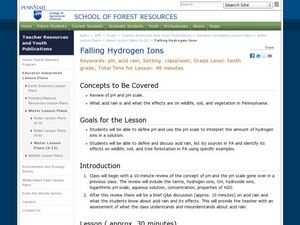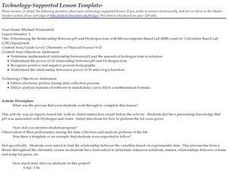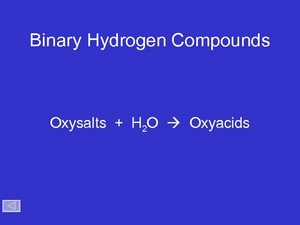Teach Learn Chem
Ions in Chemical Compounds
For this ions activity, students complete a table by combining the given ions in different combinations to make a neutrally charged chemical compound.
Creative Chemistry
Common Ions and Formulae of Ionic Compounds
This is not a learning exercise per se but a reference sheet for your chemistry class. It lists cations and anions, their chemical symbols, and their net charges. Also included is a thorough explanation of combining these ions to form...
Curated OER
Lead and Mercury Ion Catalase Inhibition
Young scholars participate in a laboratory investigation in which they observe the effect of temperature and pH on enzyme activity. Students also examine exposure to heavy metal ions and the effect that may have on enzyme activity.
Curated OER
Ternary Compounds
Practice naming ternary compounds with this PowerPoint presentation. Individual slides show the patterns for memorizing the nomenclature for polyatomic ions. Several examples are included for student practice. This thorough and...
Curated OER
Falling Hydrogen Ions
Tenth graders define pH and use it to interpret amounts of hydrogen ions in a solution. In this hydrogen lesson students read about acid rain, divide into groups and present their information to the class.
Curated OER
Common Ions and Their Charges
For this chemistry worksheet, students can use the table to observe and name the common types of ions and determine the charges to explain the gain or loss of electrons.
Curated OER
Metals vs. Non-Metals: Dot Diagrams; Ions
In this metals, non-metals, dot diagrams and ions learning exercise, high schoolers read about each of these topics and they identify if 8 elements are metals or non-metals, they draw electron dot diagrams for 5 elements, they write the...
Curated OER
Determining the Relationship Between pH and Hydrogen Ions with Microcomputer Based Lab (MBL) and/or Calculator Based Lab (CBL) Equipment
Young scholars find the relationship between the variables based on experimental data. They determine mathematical relationship between pH and the amount of hydrogen Ions in solution.
Creative Chemistry
Common Ions and Formulae of Ionic Compounds
This handout, produced in the UK, contains a chart of cations and anions. It explains how ionic compounds are formed and named. This concise and attractive handout can be helpful as a reference for your chemistry apprentices.
Curated OER
Why and How Atoms Combine
Here is a top-notch handout to supply your chemistry class with. It covers valence electrons, Lewis diagrams, the octet rule, and more! Technically it is less of a worksheet than a detailed explanation of these chemical bonding concepts....
Curated OER
Ranking Molecular Properties Based Upon Intermolecular Forces
A splendid chart of information about chemical bonding tops the first page. In it you will find information on London forces, permanent dipoles, hydrogen bonds, ionic bonds, and covalent bonds. A four-step process for assigning...
Royal Society of Chemistry
pH 2: Activity
Pupils puzzled over pH? Incorporate an interactive resource that teaches through games! Chemistry scholars use reasoning to solve puzzles that focus on determining the pH based upon hydrogen ion concentration.
Curated OER
Binary Hydrogen Compounds
Viewing this slide show prepares your chemistry scholars for chemical nomenclature. Specifically, binary hydrogen compounds and ternary compounds formed from oxyacids are dealt with. One highlight is a useful graphic organizer for naming...
Creative Chemistry
D-Block Ions as Catalysts
In this catalysts activity, students use transition metal ions to catalyze oxidation reactions of iodide ions. Students measure the rate of the reactions by measuring free iodine as a product.
Curated OER
Symbols and Formulae of Common Ions
In this ions worksheet, students complete a graphic organizer by filling in the missing names or symbols for positive and negative ions.
Curated OER
50 Ways to name Your Compound
In this compounds worksheet, students review the rules for naming compounds. Students apply these rules by writing the chemical name or formula for the 50 compounds given.
Curated OER
Atoms and Chemical Bonding
An online resource, this instructional activity has your chemistry learners complete four data tables with information about atoms and chemical bonds. The first table addresses atomic number and mass, as well as numbers of protons,...
Curated OER
Periodic Table
In this periodic table worksheet, students are given 12 terms and must match the terms to their appropriate definition. Topics include types of bonds, types of elements, and types of ions.
Curated OER
Interpreting pH
In this pH instructional activity, students read about pH and the concentration of ions in solutions that are acidic and basic. They answer four questions about pH and determine the concentration of hydronium ions and the pH given...
Texas State Energy Conservation Office
Fueling the Future
Future mechanical engineers and automotive technicians read about various solutions to using gasoline in cars. Included are electric, fuel-cell-powered, and hybrid vehicles.
Curated OER
Atomic Musical Chairs
An engaging activity enlightens young chemists in this lesson on atomic structure. They play musical chairs through a series of concentric circles that represent electon orbitals. A laundry basket in the middle holds the protons and...
Curated OER
Water: The Neutral Substance
In this water worksheet, students read about hydrogen bonds in water and the differences in electronegativity between the oxygen atom and the two hydrogen atoms in water. Students answer four questions about the structure of water and...
Curated OER
Metals vs. Non-Metals
For this elements worksheet, students compare and contrast the characteristics of metals and non-metals. Students practice drawing Lewis dot diagrams and writing ion notation. This worksheet has 9 word problems, 8 matching questions, and...
Curated OER
Writing Ionic Formulas
In this ions learning exercise, students use a table of common ions to determine how to write the chemical formula, using subscripts, to make a neutral compound. This learning exercise has 44 problems to solve.

























